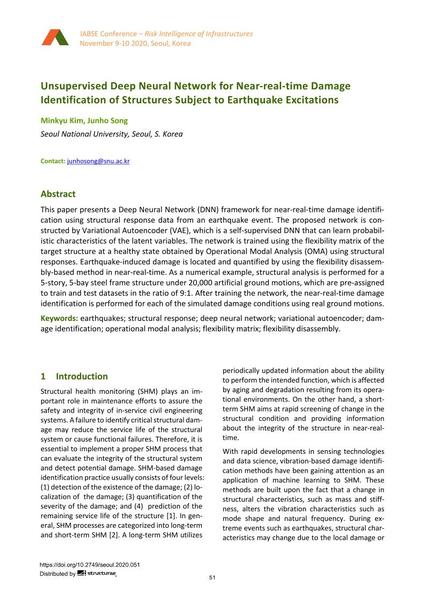Unsupervised Deep Neural Network for Near-real-time Damage Identification of Structures Subject to Earthquake Excitations

|
|
|||||||||||
Bibliographic Details
| Author(s): |
Minkyu Kim
(Seoul National University, Seoul, S. Korea)
Junho Song (Seoul National University, Seoul, S. Korea) |
||||
|---|---|---|---|---|---|
| Medium: | conference paper | ||||
| Language(s): | English | ||||
| Conference: | IABSE Conference: Risk Intelligence of Infrastructures, Seoul, South Korea, 9-10 November 2020 | ||||
| Published in: | IABSE Conference Seoul 2020 | ||||
|
|||||
| Page(s): | 51-58 | ||||
| Total no. of pages: | 8 | ||||
| DOI: | 10.2749/seoul.2020.051 | ||||
| Abstract: |
This paper presents a Deep Neural Network (DNN) framework for near-real-time damage identifi- cation using structural response data from an earthquake event. The proposed network is con- structed by Variational Autoencoder (VAE), which is a self-supervised DNN that can learn probabil- istic characteristics of the latent variables. The network is trained using the flexibility matrix of the target structure at a healthy state obtained by Operational Modal Analysis (OMA) using structural responses. Earthquake-induced damage is located and quantified by using the flexibility disassem- bly-based method in near-real-time. As a numerical example, structural analysis is performed for a 5-story, 5-bay steel frame structure under 20,000 artificial ground motions, which are pre-assigned to train and test datasets in the ratio of 9:1. After training the network, the near-real-time damage identification is performed for each of the simulated damage conditions using real ground motions. |
||||
| Keywords: |
earthquakes structural response operational modal analysis deep neural network variational autoencoder flexibility matrix flexibility disassembly
|
||||
